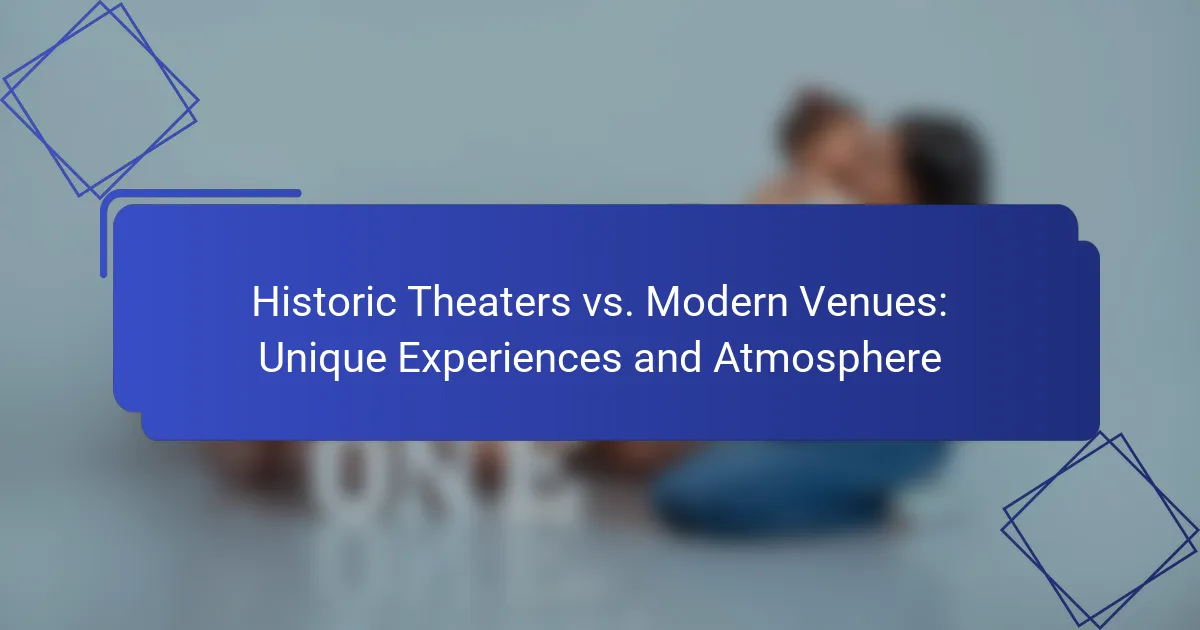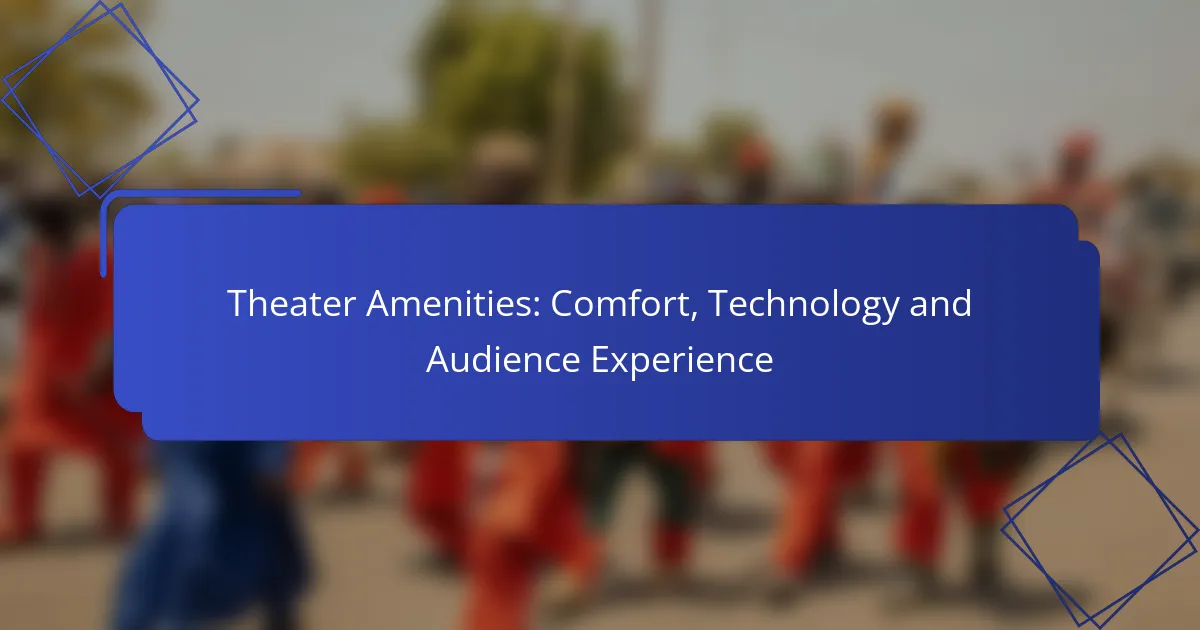Historic theaters offer a captivating blend of architectural beauty and cultural significance, providing an intimate atmosphere that enhances the audience’s experience. In contrast, modern venues leverage innovative technology and adaptable designs to create immersive and participatory environments. Both types of venues present unique experiences, shaped by their distinct characteristics and the ambiance they foster.

What unique experiences do historic theaters offer in major cities?
Historic theaters in major cities provide a distinctive blend of architectural beauty, cultural significance, and an intimate atmosphere that modern venues often lack. These theaters not only showcase performances but also immerse audiences in a rich history that enhances the overall experience.
Architectural significance
Historic theaters are often masterpieces of design, featuring ornate facades, intricate interiors, and unique architectural styles that reflect the era in which they were built. Many are equipped with original features like grand chandeliers, elaborate moldings, and vintage seating that transport visitors back in time.
When visiting a historic theater, pay attention to details such as the acoustics and sightlines, which are often superior due to the craftsmanship of the past. This architectural significance can greatly enhance the enjoyment of performances, making each visit a memorable occasion.
Cultural heritage events
Many historic theaters host cultural heritage events that celebrate local history and traditions, including film festivals, live performances, and community gatherings. These events often highlight regional artists and showcase works that resonate with the local audience, fostering a sense of community and pride.
Participating in these cultural events can provide deeper insights into the local culture, making your experience richer. Look for seasonal festivals or special performances that highlight the theater’s historical significance and its role in the community.
Intimate atmosphere
The intimate atmosphere of historic theaters creates a unique connection between performers and audiences. With smaller seating capacities compared to modern venues, attendees often feel more engaged and personally involved in the performance.
This closeness can enhance emotional responses to the show, making it a more impactful experience. When choosing a historic theater, consider the seating arrangement and proximity to the stage to maximize this intimate experience.
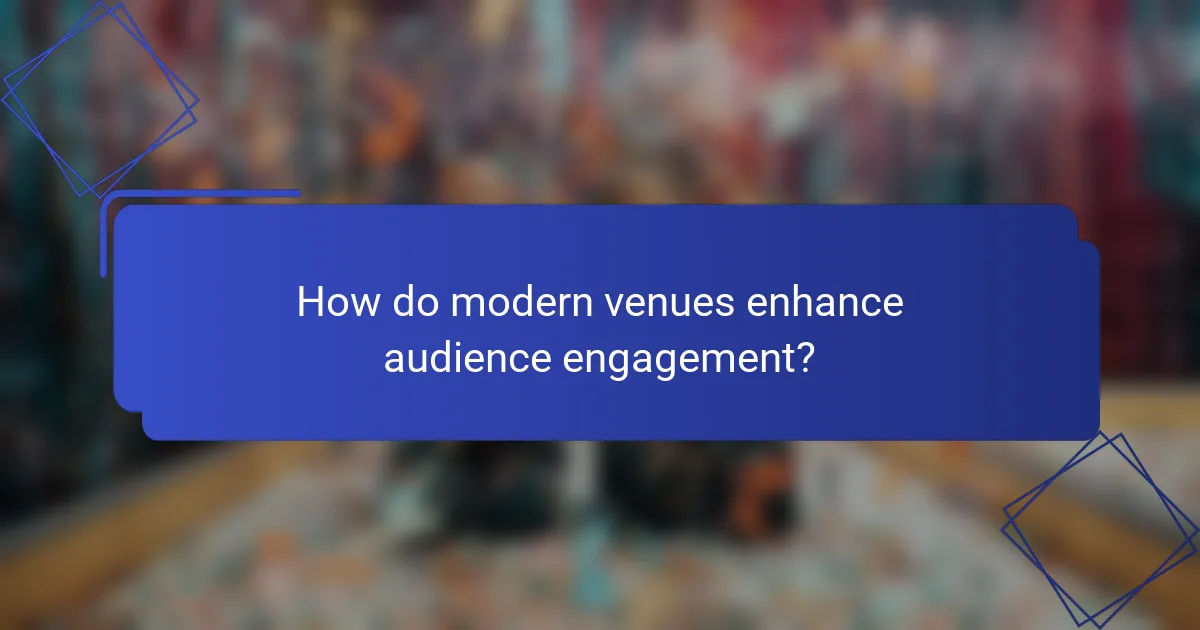
How do modern venues enhance audience engagement?
Modern venues enhance audience engagement through innovative technology, adaptable seating, and interactive experiences. These elements create a more immersive and participatory environment for attendees, making events more memorable.
Advanced technology integration
Modern venues utilize advanced technology to create dynamic experiences. High-definition screens, state-of-the-art sound systems, and mobile apps for event navigation are common features that enhance the overall atmosphere. For example, venues may incorporate augmented reality elements that allow audiences to interact with the performance in real-time.
Additionally, many venues offer live streaming options, enabling remote audiences to participate in events. This integration not only broadens the reach of performances but also allows for interactive polls and feedback during shows, fostering a sense of community among viewers both on-site and online.
Flexible seating arrangements
Flexible seating arrangements in modern venues allow for a variety of configurations tailored to specific events. Unlike traditional theaters, which often have fixed seating, contemporary spaces can be reconfigured to accommodate different audience sizes and types of performances. This adaptability can enhance comfort and engagement, as attendees can choose seating that best suits their preferences.
For instance, venues may offer options like cabaret-style seating for intimate performances or tiered seating for larger productions. This flexibility not only improves sightlines but also encourages social interaction among audience members, contributing to a more engaging experience.
Interactive experiences
Interactive experiences are a hallmark of modern venues, allowing audiences to engage with performances in unique ways. Many venues now incorporate elements such as audience participation, live Q&A sessions, and immersive storytelling techniques that invite attendees to become part of the show. This level of involvement can significantly enhance the emotional impact of the performance.
Moreover, venues often utilize social media platforms to encourage audience interaction before, during, and after events. For example, hashtags may be promoted to facilitate discussions online, while live polls can gauge audience reactions in real-time, creating a more connected and engaging atmosphere.
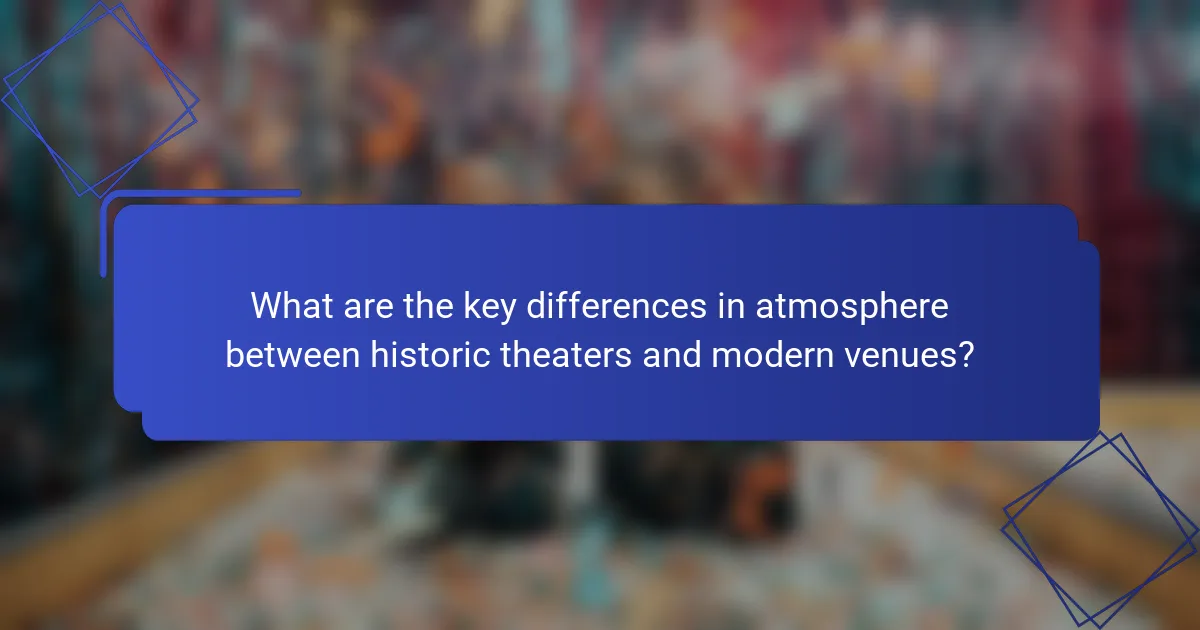
What are the key differences in atmosphere between historic theaters and modern venues?
Historic theaters often exude a unique charm and character that modern venues may lack, creating a distinct atmosphere for performances. The differences in design, acoustics, and audience engagement contribute significantly to the overall experience.
Ambiance and decor
Historic theaters typically feature ornate architecture, vintage furnishings, and intricate details that reflect the era in which they were built. This can create an immersive experience, transporting audiences back in time. In contrast, modern venues often prioritize sleek, minimalist designs that focus on functionality over aesthetic charm.
For example, a historic theater might showcase grand chandeliers and plush velvet seats, while a modern venue may utilize industrial materials and open layouts. This difference in ambiance can influence the emotional connection audiences feel during performances.
Acoustic properties
The acoustic design of historic theaters is often tailored to enhance sound quality, utilizing materials and shapes that have been refined over decades. These venues may have high ceilings and curved walls that amplify sound naturally. In contrast, modern venues frequently employ advanced technology to achieve optimal acoustics, which can sometimes lead to a less organic sound experience.
When choosing a venue, consider the type of performance. For classical music or theater, a historic theater may provide a richer auditory experience, while modern venues might excel in versatility for various genres.
Audience interaction
Historic theaters often foster a sense of intimacy, with closer seating arrangements that encourage audience engagement. This layout can enhance the connection between performers and spectators, making the experience feel more personal. Modern venues, however, may prioritize capacity and sightlines, which can create a more detached atmosphere.
Additionally, many historic theaters have traditions, such as audience participation or themed events, that enhance interaction. In contrast, modern venues might focus on high-tech enhancements, such as mobile apps for real-time feedback, which can alter the nature of audience involvement.

How do location and accessibility impact theater choice?
Location and accessibility significantly influence theater choice by determining how easily audiences can reach a venue. Factors like urban versus suburban settings, public transport availability, and parking options all play a crucial role in the overall experience.
Urban vs. suburban settings
Urban theaters often benefit from higher foot traffic and a vibrant atmosphere, attracting larger audiences. These venues are typically located near restaurants, bars, and other entertainment options, enhancing the overall experience.
In contrast, suburban theaters may offer a more relaxed environment with spacious seating and less crowded conditions. However, they might lack the same level of cultural offerings and nightlife that urban settings provide.
Public transport availability
Public transport availability can greatly affect theater attendance. Venues situated near major transit lines, such as subways or bus routes, make it easier for patrons to reach the theater without needing a car.
When choosing a theater, consider the proximity to public transport options. A venue with good access can increase attendance, while those in areas with limited transport may struggle to attract audiences.
Parking options
Parking options are a critical consideration for many theatergoers, especially in urban areas where parking can be limited and expensive. Venues that provide ample parking or validation for nearby lots can enhance the convenience for attendees.
When selecting a theater, check for available parking facilities and their costs. Some theaters may offer free or discounted parking, which can be a deciding factor for those driving to the event.
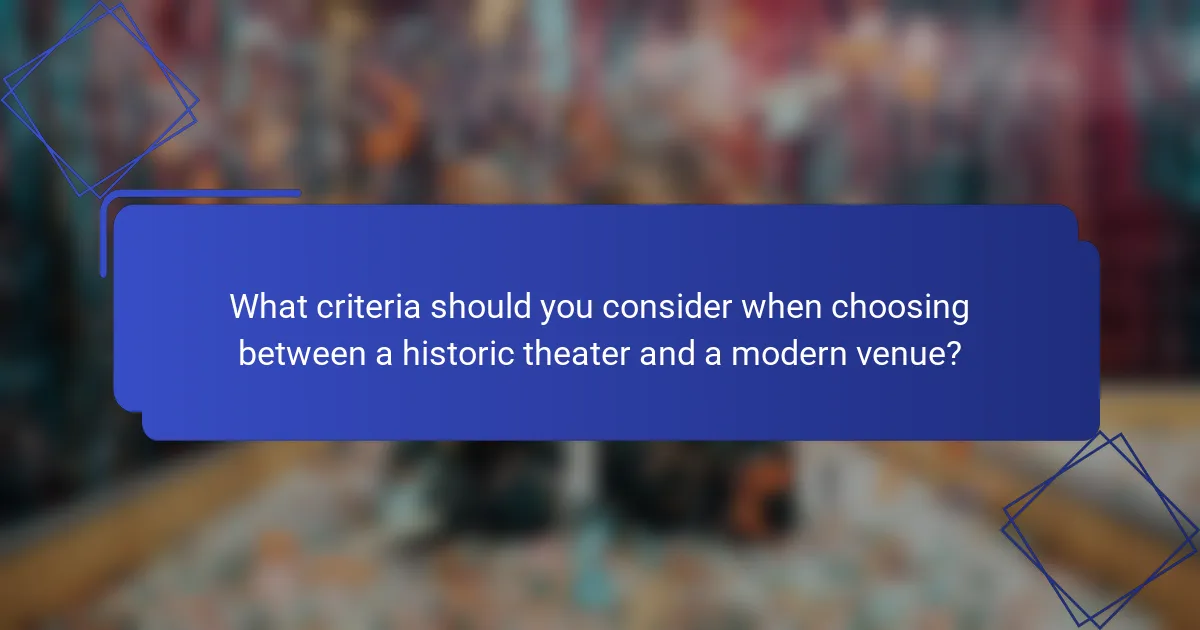
What criteria should you consider when choosing between a historic theater and a modern venue?
When deciding between a historic theater and a modern venue, consider the event type, audience preferences, and budget. Each option offers distinct experiences that can significantly impact the overall enjoyment and success of your event.
Event type suitability
Different events may be better suited to either historic theaters or modern venues. For instance, classic performances like opera or ballet often thrive in historic settings, where the ambiance enhances the experience. Conversely, modern venues are typically designed for versatility, making them ideal for concerts, corporate events, or large-scale productions.
Assess the specific requirements of your event, such as stage size, seating arrangement, and technical needs. A modern venue might offer advanced sound and lighting systems, while a historic theater may have unique architectural features that contribute to the event’s theme.
Audience preferences
Understanding your audience’s preferences is crucial when choosing between a historic theater and a modern venue. Some attendees may appreciate the charm and nostalgia of a historic setting, while others might prefer the convenience and amenities of a modern space. Consider conducting a survey or gathering feedback to gauge what your audience values most.
Additionally, think about accessibility and comfort. Modern venues often provide better facilities for those with mobility challenges, while historic theaters may have limitations due to their age and design.
Budget considerations
Your budget will play a significant role in determining whether to choose a historic theater or a modern venue. Generally, historic theaters may have lower rental fees but could incur additional costs for maintenance and compliance with safety regulations. Modern venues might have higher upfront costs but often include amenities that can save money in the long run.
When budgeting, factor in not just the rental fee but also potential expenses for equipment, catering, and additional services. Create a detailed budget plan to ensure you can accommodate all necessary elements for a successful event.
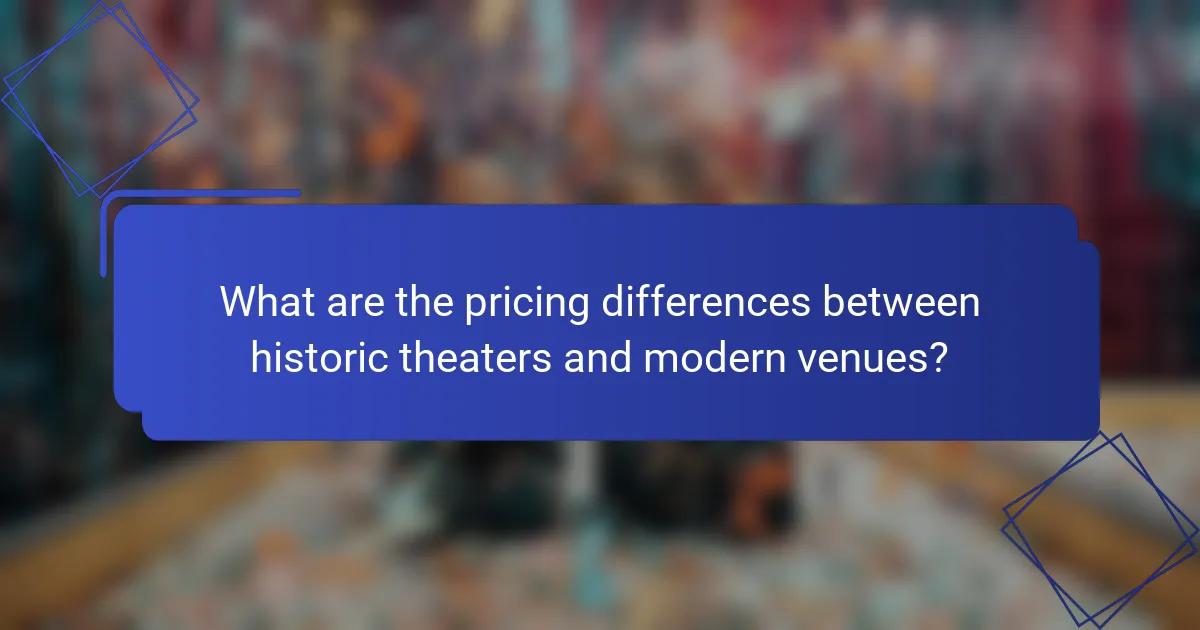
What are the pricing differences between historic theaters and modern venues?
Pricing differences between historic theaters and modern venues can vary significantly based on location, seating options, and the type of performance. Generally, historic theaters may offer lower ticket prices due to their unique charm and community support, while modern venues often charge more for advanced technology and amenities.
Ticket price variations
Ticket prices at historic theaters typically range from the low tens to mid-hundreds of USD, depending on the performance and seating. In contrast, modern venues may charge higher, often starting at around $50 and reaching several hundred dollars for premium seats. Factors such as the popularity of the show, the day of the week, and the venue’s location can influence these prices.
When purchasing tickets, consider looking for discounts or special promotions at historic theaters, as they often engage with local communities and may offer lower rates for students or seniors. Modern venues might provide tiered pricing based on seat location, so it’s wise to compare options before buying.
Concessions and amenities
Concessions at historic theaters usually feature traditional snacks like popcorn and candy, often at lower prices than modern venues, where gourmet options and alcoholic beverages are common. Prices for concessions can range from a few dollars for basic snacks to over $10 for specialty items in modern venues.
Modern venues often provide enhanced amenities, such as comfortable seating, advanced sound systems, and even dining options. While these features can improve the overall experience, they may also contribute to higher ticket prices and concession costs. When choosing between the two, consider what amenities are most important to you and how they fit into your budget.
